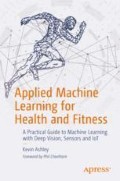Abstract
This chapter provides an overview of physical principles used in modern sport science. In addition to physics, kinesiology, and biomechanics, we will also discuss how deep learning can help a sport data scientist, and vice versa, how we can improve our models by knowing a few physics principles. Classical mechanics is a reliable method of movement analysis, and it’s a valuable tool if you’re planning to build any practical sport machine learning models. In this chapter, I’ll show how machine learning models, including neural nets and reinforcement learning, can be applied to biomechanics.
Access this chapter
Tax calculation will be finalised at checkout
Purchases are for personal use only
Author information
Authors and Affiliations
Rights and permissions
Copyright information
© 2020 Kevin Ashley
About this chapter
Cite this chapter
Ashley, K. (2020). Physics of Sports. In: Applied Machine Learning for Health and Fitness. Apress, Berkeley, CA. https://doi.org/10.1007/978-1-4842-5772-2_2
Download citation
DOI: https://doi.org/10.1007/978-1-4842-5772-2_2
Published:
Publisher Name: Apress, Berkeley, CA
Print ISBN: 978-1-4842-5771-5
Online ISBN: 978-1-4842-5772-2
eBook Packages: Professional and Applied ComputingApress Access BooksProfessional and Applied Computing (R0)

